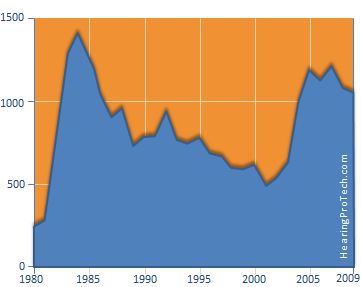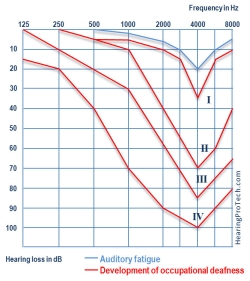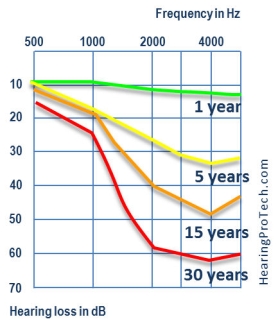Sound has multiple effects on the body: auditive problems such as tinnitus or hearing loss, and non-auditive problems such as stress, fatigue and even cardio-vascular diseases.
Auditory effects
Auditory effects relate to hearing loss and may occur in the following forms:
- tinnitus: whistling sound, buzzing in ears
- temporary hearing loss: results from exposure to high sound levels; hearing gradually returns after exposure (many hours)
- acoustic trauma: Hearing damage caused by a very loud and brief noise (explosion, gunshot, firecrackers, etc.)
- permanent hearing loss: Typical of prolonged everyday exposure to noise (8 hours at 80 dB (A)). The gradual damage to hearing that takes place over months and years is insidious. It is noticeable only when it causes problems such as difficulties in communication between the subject and people around him. The injuries sustained are then irreversible and final.
Hearing loss is the 4th most common occupational disease. On average, it costs 94,000 euros.
Prolonged exposure to loud noise levels gradually destroys the hair cells in the inner ear. It gradually leads to deafness (perceptive deafness), which is irreversible. In this case, surgery does not help. Electronic aids simply amplify the residual acuity, they do not restore the hearing function as a whole.
Deafness can be recognized as an occupational disease according to specific medical, professional, and administrative criteria, given in Table No. 42 of occupational diseases under the general system and Table No. 46 under the agricultural system. Table No. 42 has been amended several times, notably in 1981 and 2003, where the criteria for recognition were extended. So the number of cases of recognized deafness has increased sharply in the years that followed. The peak for the year 2005 visible on the graph is thus related to the expansion of criteria in Table 42 done in 2003.
Number of occupational deafness recognized since 1980
Graph 3 shows the different stages of development of occupational deafness.
Habituation phase: An audiogram performed late in the day can already show a reversible auditory scotoma ("deaf spot") at a frequency of 4000 Hz.
Stage I or stage of latent deafness: Hearing loss is characterized by irreversible auditory scotoma at a frequency of 4000 Hz exceeding 30 dB.
Stage II or the incipient deafness stage: The auditory scotoma is extended to neighboring frequencies (2000-6000 Hz) and exceeds 30 dB.
Stage III or the confirmed deafness stage: Hearing loss extends to frequencies 1000-8000 Hz and exceeds 30 dB.
Stage IV or the severe hearing loss stage: The hearing loss reaches all frequencies including 500 Hz (≥ 30 dB), with a predominant extension over high frequencies.
Graph 3: Development of occupational deafness
We see on Graph 4, a study in the form of an audiogram done every 5 years on a worker exposed to noise during his entire career without hearing protection.
Graph 4: Hearing development of an employee exposed to 95dB (A) for 30 years
Non-auditory effects
Non-auditory effects are sources of:
- anxiety, depression, stress, irritability or aggression
- sleep disturbances, insomnia
- fatigue, decreased concentration
- effects on the cardiovascular system
- an increased risk of occupational accidents







